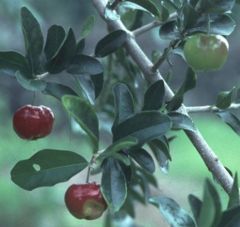Acerola
| Acerola {{{status}}} Fossil range: {{{fossil_range}}}
| ||||||||||||||||||||||||||||||||||||||||||||||||||||||||||||||||||
|---|---|---|---|---|---|---|---|---|---|---|---|---|---|---|---|---|---|---|---|---|---|---|---|---|---|---|---|---|---|---|---|---|---|---|---|---|---|---|---|---|---|---|---|---|---|---|---|---|---|---|---|---|---|---|---|---|---|---|---|---|---|---|---|---|---|---|
 | ||||||||||||||||||||||||||||||||||||||||||||||||||||||||||||||||||
| Plant Info | ||||||||||||||||||||||||||||||||||||||||||||||||||||||||||||||||||
| ||||||||||||||||||||||||||||||||||||||||||||||||||||||||||||||||||
| Scientific classification | ||||||||||||||||||||||||||||||||||||||||||||||||||||||||||||||||||
| ||||||||||||||||||||||||||||||||||||||||||||||||||||||||||||||||||
| [[{{{diversity_link}}}|Diversity]] | ||||||||||||||||||||||||||||||||||||||||||||||||||||||||||||||||||
| {{{diversity}}} | ||||||||||||||||||||||||||||||||||||||||||||||||||||||||||||||||||
| Binomial name | ||||||||||||||||||||||||||||||||||||||||||||||||||||||||||||||||||
| Malpighia glabra L. | ||||||||||||||||||||||||||||||||||||||||||||||||||||||||||||||||||
| Trinomial name | ||||||||||||||||||||||||||||||||||||||||||||||||||||||||||||||||||
| {{{trinomial}}} | ||||||||||||||||||||||||||||||||||||||||||||||||||||||||||||||||||
| Type Species | ||||||||||||||||||||||||||||||||||||||||||||||||||||||||||||||||||
| {{{type_species}}} | ||||||||||||||||||||||||||||||||||||||||||||||||||||||||||||||||||
| {{{subdivision_ranks}}} | ||||||||||||||||||||||||||||||||||||||||||||||||||||||||||||||||||
| [[Image:{{{range_map}}}|{{{range_map_width}}}|]] | ||||||||||||||||||||||||||||||||||||||||||||||||||||||||||||||||||
| Synonyms | ||||||||||||||||||||||||||||||||||||||||||||||||||||||||||||||||||
| {{{synonyms}}} |
Acerola (Malpighia glabra), also known as Barbados cherry or wild crapemyrtle, is a tropical fruit-bearing shrub or small tree in the family Malpighiaceae, native to the West Indies and northern South America and also cultivated in India. It grows to 3 m tall, with a dense, thorny crown. The leaves are evergreen, simple ovate-lanceolate, 5-10 cm long, with an entire margin. The flowers are produced in umbels of 2-5 together, each flower 1-1.5 cm diameter, with five pink or red petals.
The fruit is bright red, 1.5-2 cm diameter, containing 2-3 hard seeds. It is juicy, often as much sour as sweet in flavor, and very high in vitamin C and other nutrients.
Cultivation and uses
The fruit is edible and widely consumed in the species' native area, and is cultivated elsewhere for its high vitamin C content.
In the 1950s, a manufacturer of baby food decided that apple juice was milder for infants than orange juice. The company claimed that a drop of acerola juice in an 8 oz. can of apple juice provided the amount of vitamin C of an equal amount of orange juice. Template:Fact
In Puerto Rico, the acerola is so prized that custom officials exercise considerable precaution to prevent exporting of acerola cuttings.